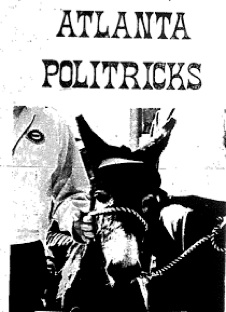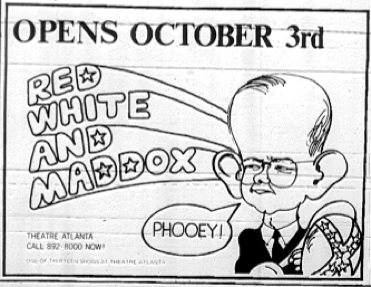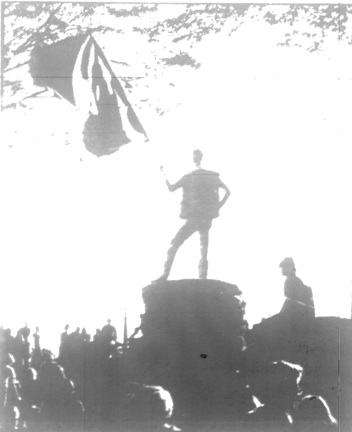Poli-TRICKS



Clark Harrison, Jr. was my uncle. He was the first WWII paraplegic to leave the VA hospital and live. He learned to fly his own plane and published his autobiography after being chairman of Dekalb County Commissioners. Taking this stand was considered crazy at the time, but was inspiring to me. The best politician I ever knew.
PAGE 14A DeKALB NEW ERA WEDNESDAY, OCTOBER 5, 1972
Harrison Tells Why He Supports McGovern
Two, prominent DeKatb County citizens - Clark Harrison and former Congressman James A. Mackay - have publicly endorsed the Presidential candidacy of Sen. George McGovern.
In last week's issue of the DeKalb News, Mr. Mackey, a Decatur attorney and former U.S. Congressman, emphasized his support for the Democratic candidate, and closed with the comment that "Senator McGovern is simply asking us to be something different than a modern, militaristic Rome.”
Clark Harrison, the out-going Chairman of the Dekalb County Board of Commissioners, is the head of the Dekalb drive to elect Senator McGovern.
Here, in an assessment of his desire to see George McGovern elected, dark Harrison speaks candidly about war, patriotism and the economy of a nation.
By CLARK HARRISON
My endorsement of George McGovern for President is based on personal conviction that goes back many years.
I was in a hospital in England in 1944 when President Roosevelt and Prime Minister Churchill made their historic demand for the 'unconditional surrender of Nazi Ger-.any and Imperial Japan. I felt strongly at the time, and since that this unnecessary political statement cost the lives of young Americans.
Since I was wounded in combat, I have always felt strongly about the political use of patriotism of our young men. Historians have confirmed the feeling I had at the time about the 'unconditional surrender' statement, and I believe they will confirm the feelings many have today that the Viet Nam War, and the Presidential visits to Red China and Russia, have been used in a 'political effort by President Nixon to assure his re-election in 1972.
The tragedy of this day is the fact that alter four more war years under Nixon, we can no better control the internal situation in Viet Nam than we could have when Richard Nixon took office in 1969 - and 20,000 young Americans have been killed in action in the intervening years.
1 am convinced we can stay in Viet Nam another 10 years and the final situation in that unhappy country will not be substantially improved.
We are told today that the only reason we do not totally withdraw, now, is because of our prisoners of war - and yet, there are 550 more Americans held prisoner in Viet Nam today than in 1969. And, every day, American men fly over North Viet Nam, and are exposed to capture or death.
President Nixon sold one-fourth of the U.S. wheat crop to Russia in a deal they have sought for years—and did not secure the release of a single American prisoner.
***
Domestically, the Viet Nam War has been used to silence critics of what has been the most disastrous administration of this century.
The disaster of the Nixon Administration has been that our involvement in a war we cannot win has been continued at great expenditure of this nation's wealth, and without a corresponding tightening of our civilian belts.
We have, in effect, been told that we can have 'guns and butter,' and the result has been disaster to our economy with the bill paid in inflation, devaluation of the dollar, a stock crash that cost the small investor literally billions, and an unprecedented high in unemployment.
The price of the Nixon Administration has been paid by the youth of America, by the wage earner, whose income has been fixed, and by the elderly.
The most alarming development is the apparent intent of the Nixon administration to continue these policies for another four years.
I have always been proud that I could serve my country in combat in World War II. I hope today, that whatever influence I may have will be on the side of preserving the ideals that made this country worthy of the sacrifice of our young men.
At the moment, that means, for me, voting for George McGovern.
A Warm Welcome
George Wallace Comic , read and understand what a uniquely uphill struggle hips had in the South to even reach the level above meeting any change with violence.


Remember Lester Maddox had been elected Governor because he was a segregationist given to violence. He was nationally known for having threatened any “colored” people who would come to his restaurant. His other talent was riding a bicycle backwards in parades. Really.

Atlanta Journal 4/6/67
Lester’s Vigilantes
GOV. LESTER Maddox has announced the formation of a Committee of One Thousand, made up of people all over the state. Its object is to tell him what is going on.
Through history more innocent people have " been hung, burned, pressed to death, stoned, exiled, stretched on racks and calumnied by this means than by any other.
The spirit of the committee is the spirit of the old Klan. In the good old days here in Georgia people were lynched, tarred and feathered, fired from their jobs and driven from the county by means of just this sort of friendly information.
The idea is as old as injustice. as built-in as human spite, and has been the favorite device of dictators in all times and places.
THE IDEA is mistake and ought to be dropped before the reputation of the first innocent citizen has been damaged.
But to give the governor credit, there is a shadow of justification for this committee. He says its object is to keep a watchful eye on the functions of state government.
A watchful eye indeed is needed.
The law is supposed to provide it.
Is the governor's suggestion a measure of the failure of our legal syslem?
If so the remedy is reform of the system, and not vigilantes.
And what about the independent watchdog agency, proposed in and so handily defeated by Gov. Maddox's Senate?
Could members of the Governor’s committee be the reason firebombings of troublesome Civil Rights and Counter Culture buildings around Atlanta never seemed to get solved or sometimes even investigated? makes you go, “hoomm?”
It is amazing to see what we DID accomplish with the US government working so hard to defeat any changes in society. COINTELPPRO was very active in Georgia because of Fort Benning and its still secret training areas.
The Vietnam War’s shadow affected everything. Flunking a test, or a lottery could send you off to war. People returning to the Real World found it hard to believe, petty, and self-absorbed. Many were physical, emotional, or psychological shells of what they had been before.
For a history of the events of Vietnam look here:
http://www.leatherneck.com/forums/archive/index.phpt-1018.htmlVietnam
What concerned the various sectors of the United States ruling elites in regard to SNCC’s position against the draft and the war in Viet Nam was that the organization was actively challenging the notion that Africans in America should fight in unjust wars overseas. In January of 1966, SNCC issued a detailed statement opposing the war in Viet Nam. In August of the same year there were picket lines set up outside a selective service induction center in Atlanta, Georgia by members of the Student Nonviolent Coordinating Committee. The demonstrations resulted in the arrest of numerous activists and drew the attention of the FBI.
In a confidential FBI report issued on September 7, 1966 entitled: “Student Nonviolent Coordinating Committee Stokely Carmichael”, the Bureau sought to provide a summary of recent activities of SNCC and its chairperson. Under the beginning section of the report entitled: “Picketing Activities Atlanta, Georgia,” it states that: “Since August 17, 1966, a small group of Negroes, the majority of whom are members of the Student Nonviolent Coordinating Committee, have been picketing the Twelfth Corps Headquarters, Northeast, Atlanta, Georgia, protesting United States action in Vietnam and United States Negroes fighting in Vietnam. A number of these individuals have been arrested by the Atlanta Police Department and charged with various offenses ranging from disorderly conduct to assault and battery. The activities of these individuals in connection with their picketing of the Twelfth Corps Headquarters are also under investigation by the Federal Bureau of Investigation relative to destruction of Government property and possible violations of the Selective Service Act of 1948.”
The confidential report of the FBI continues by making reference to a speech made by Carmichael on September 3, 1966 and a rebellion which erupted on September 6 in Atlanta. According to the FBI report: “A confidential source advised that the Student Nonviolent Coordinating Committee sponsored a rally in a predominantly Negro neighborhood in Atlanta, Georgia, on September 3, 1966. Stokely Carmichael made a short speech at the rally. He attacked the Atlanta Police Department on police brutality matters. According to the source, Carmichael stated Negroes should form vigilante groups to observe police and should any acts of police brutality be observed, a committee should be formed among the Negro element to follow such matters.”
After the arrest of the pickets at the Twelfth Corps Headquarters, a delegation of SNCC members including Carmichael went to the Atlanta City Hall to demand a meeting with Mayor Ivan Allen. The SNCC members asked that the Mayor release the people arrested at the induction center. The Mayor replied that it was a federal matter and was beyond the control of the city of Atlanta. Carmichael was reported to have insisted that the city do something to affect the release of the demonstrators. Nonetheless, the Mayor abruptly ended the meeting by suggesting that the delegation become registered voters in the city. SNCC later held a street rally that same day, September 6, in emergency response to the police shooting of an African-American youth who was supposedly a suspect in a car theft.
Mayor Ivan Allen, who went to the scene of the rally in an attempt to calm the growing angry crowd, was pelted with rocks and bottles while standing on top of a police car. When the crowd began to rock the police vehicle the Mayor fell off after the roof buckled under pressure. The crowd grew rapidly and began to fight police in the surrounding neighborhood of Summerhill. The Mayor sent in a thousand police officers utilizing teargas and other forms of force to quell the rebellion in Atlanta. Allen immediately blamed SNCC for the unrest in Atlanta’s Summerhill District. Carmichael had issued an appeal over radio station WAOK asking that people come to the sight of the shooting of the youth by the police. The first two people arrested on the scene were SNCC members Bill Ware and Robert Walton for inviting people to broadcast their eyewitness accounts of the shooting by the Atlanta police over a loudspeaker.
Two days later Carmichael was arrested and charged with incitement to riot. On that same day another disturbance erupted in the Boulevard Section of the city after a black youth was shot to death on his porch by a white parolee, who was later sentenced to life in prison the following year. Hosea Williams of SCLC then attempted to organize a demonstration in the city after the arrest of numerous SNCC members, however, he was detained himself for leading a peaceful procession in the area where the youth was gunned down on his porch. The disturbances in Atlanta gained nationwide coverage with the scene of Mayor Allen being pushed off the hood of a police car repeatedly shown over national television. Atlanta, a southern city that attempted to cultivate an image of being moderate and business-oriented, was exposed as a bastion of racism and police brutality as well as intolerance to peaceful protest and other forms of dissent.
In the same confidential FBI report mentioned above that was issued on September 7, 1966, the bureau provides its own interpretation of the events on September 6 in Atlanta. The report states that: “The Student Nonviolent Coordinating Committee scheduled a rally at Capital and Ordman Streets, Atlanta, Georgia, on the afternoon of September 6, 1966, in protest of the arrest and shooting of a Negro male for auto theft earlier in the day. During the rally several unidentified Negroes talked to the group in a haranguing manner. Members of the group started throwing rocks and bottles at police officers and white spectators. Ivan Allen, Jr., Mayor of Atlanta, was unsuccessful in quelling the disturbance. Several acts of violence occurred resulting in the arrest of seventy-two people by the Atlanta Police Department; however, specific charges are not known.”
Pressures mounted against SNCC throughout 1966 resulting from its positions on black power, the draft, self-defense, urban rebellion and the escalating war in Viet Nam. With the release of selected FBI documents of Stokely Carmichael since his death in 1998, the unclassified records of American intelligence and the White House have provided clearer insights into the role of not only the FBI’s Counter-intelligence Program COINTELPRO, but the direct involvement of the Johnson administration and the United States Military in efforts aimed at the destruction of the civil rights and black power movements that were in strong evidence during 1966.
Editor’s Note: The FBI documents utilized in this article can be found on the Bureau’s web site: http://foia.fbi.gov/foiaindex/carmichael_stokely.htm The files have been divided into five parts and are published without comment or interpretation. These documents by no means represent the totality of FBI and other government agencies’ surveillance activities directed at Stokely Carmichael and the Student Nonviolent Coordinating (SNCC). However, the examination of these records illuminate the thinking of the Johnson administration, the Department of Justice, the Secret Service, local police agencies and municipal and county governments in regard their efforts designed to stifle and eliminate the civil rights and black power movements of the time period.




